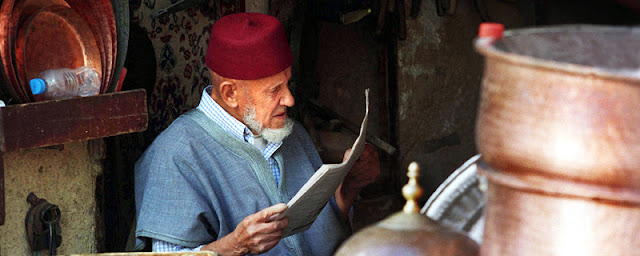The "February 20 movement" called for today's protests to go ahead despite King Mohammed VI announcing sweeping democratic reforms last months, including an elected prime minister and broader personal freedoms. The first indications are that the turnout has been smaller than expected with only a few hundred people protesting here in Casa.
According to several sources, around 2,000 people, including many Islamists, rallied in Rabat earlier today. Analysts say that quick action by the King in announcing reforms has blunted the protests. His reaction was seen as positive by a majority of Moroccans.
AFP are also reporting small but vocal demonstrations."The Moroccan people demand change!" protesters shouted in the city, calling for the government to resign and holding up placards reading: "For the freedom and dignity of the Moroccan people."
No major police presence could be seen.
AFP is also reporting only several hundred people protesting in Casablanca, chanting "No to corruption and cronyism."
The situation in Fez was also calm, however some shopkeepers in the Medina have shut for the day.
Later in the day the reports varied about the number of people marching. UK news sources estimated housands joined protests in Casablanca, in Tangiers in the north, and in Agadir on the Atlantic coast where witnesses said several thousands were marching.
A government official said at least as many were protesting as on February 20 when interior ministry estimates were 37,000.
Protests were expected in other Moroccan cities to mark a month since demonstrations first erupted in the country as part of a tide of contestation sweeping the Arab world.
Cheikh Abdeslam Yassine’s Islamist association “Justice and spirituality” known as “Adl Wal Ihsan” called on its troops to join the March 20th rally, as an attempt to regain attention and to try to stick closer to the February 20th Facebook movement, although there is no ideological harmony between the two movements.
Supporters of the 83-years old Sheikh marched in Rabat and Casablanca, but refused to merge alongside with the young Facebook leaders who they judge are "infidels who eat during the holy month of Ramadan”. Therein lies the paradox of a movement in clear regression, but nevertheless who wishes to recover through melting together within the “Arab Spring” protest movements. Movements that are mostly using social network tools to reject the repository advocated by Islamist Sheikh Yassine organization and ask instead for more freedom and openness in Moroccan society.
Locally, the message apparently has been heard at the very highest level and King Mohammed VI launched in a speech on March 9th the most ambitious reform program ever witnessed in the Arab world through the establishment of a reform commission given the task to amend the constitution. The commission, led by respected jurist Abdellatif Mennouni, is to propose more executive power to the prime minister and to parliament, and implement the decentralization program which will be voted by this summer.
The king’s speech, welcomed by Moroccans as well as by the international community, would greatly displeased Al Adl Wal Ihsane organization and widened the gap between their demands and those of young Moroccans.
Despite the fact that Morocco has remained calm during so much international unrest, there has been an impact on tourist numbers. Many hotels and guesthouses report cancellations. Tourism experts say that although there is a shortterm downturn, the future looks bright as people realise that Morocco is a safer destination.
















































